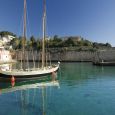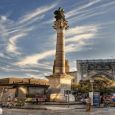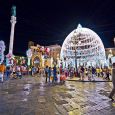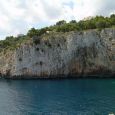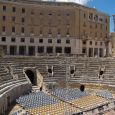Lecce
Advertisement
By Air
The city is served by the International Airport of Salento Brindisi, was recently built the new Airport City Terminal of Lecce.
By Train
Rail connections are secured from the station to the north of the State Railways, part of the circuit Centostazioni.The station of Lecce is an important railway junction of Puglia, the end point of the historic Adriatic Railway.In addition, the local service is provided by the South East Railways.
By Road
The city is surrounded by a ring highway, with characteristics of freeway.The mobility is ensured to the north from the highway 613 Lecce-Brindisi, Bari and continues for integrating with the Adriatic Highway 16 and the SS 379, enjoying excellent transport links to the motorway network.To the south branch out two important characteristics of highway salting roads: State Road 101 Salento Gallipoli and the Adriatic Highway 16 in the stretch Lecce-Maglie.It is also possible to reach through the State Road 7 Taranto Via Appia.
By Trolleybus
In Lecce trolleybus was built a network composed of single lines for a total of 26 km.However it is not yet come into service even though the work was completed in 2007.The means used will be the Van Hool A330T.
Chinese Missionary Museum and Natural History
is a museum of natural Lecce.The collection preserved in this museum is the fruit of the objects that the missionaries of the Friars Minor have collected during their pilgrimages to the East over the centuries.You can visit the rare objects, tapestries, statues, musical instruments, as well as herbals, shells, corals, specimens of terrestrial and marine wildlife. The collection is constantly enriched by donations and partnerships with the University of Salento, the WWF and Legambiente.Currently, the museum was transferred to the Sava (Italy) at the premises of the Convent of St. Francis of Assisi.
Provincial Museum
Is an art museum of Lecce.The Museum is housed in rooms adjacent to the thirteenth century Abbey of Santa Maria di Cerrate in places Casalabate about 7 km from the city.The museum includes two sections. The first proposes sculptures and architectural fragments of the Romanesque , from the Abbey. The second section is devoted to objects, traditions and crafts of rural Salento : the tools of rural work, ceramics, pottery and a series of papier-mâché statues.In some local areas are perfectly reconstructed domestic housing of Salento, including a fully equipped kitchen, a bedroom with its furnishings and the room of the frames where the women wove fine fabrics.Of note is the presence of two tanks and some mills to grind the olives in their original position.
Franciscan Art Gallery
is an art museum of the Franciscan Lecce.The Art Gallery, owned by the Franciscan Friars, is housed in the palace of the sixteenth century, Fulgence.It hosts hundreds of sixteenth-century paintings, seventeenth and eighteenth century, for the most part derived by Luca Giordano and Solimena and from Franciscan monasteries in Apulia.At the end of the path in the picture gallery you can visit the Nymphaeum of Fulgencio, a place built to cool off hot and muggy summer days in Salento, in the chilled water gushing from the fountains.
Archaeological Museum of Sigismondo Castromediano
is an archaeological museum of Lecce.It is the oldest museum in the Apulia, founded in 1868 by Sigismondo Castromediano, Duke of Cavallino, preserves numerous testimonies of Messapian civilization and Roman settlements.In the prehistoric section was rebuilt the Grotta dei Cervi at Porto Badisco, with interesting paintings.In the Art Gallery, located upstairs of the building are paintings that document the Byzantine and Venetian influences on the work of local artists from the Middle Ages until the eighteenth century.One section is devoted to so-called minor arts: ceramics, pottery, ivory, bronze and silver from the Baroque period.After the death of Duke Castromediano, the museum was left to fend for himself and many exhibits inside went to enrich other museums in Italy, including that of Taranto, which was enriched over time to the point of becoming the national museum, to the detriment of the oldest museum of Lecce, who remained Provincial Museum.In recent years, however, has received the new splendor that has given him new prestige.At the same plexus is the Provincial Library, containing over 1000 writings, including books, magazines and newspapers of that time.In addition to it there is a large study room.
Roman Amphitheatre of Lecce
is a monument located in the central Roman piazza Sant Oronzo.For size turns out to be the most important Roman of all Apulia.Dates back to the Augustan Age.The monument was discovered during the construction of the building of the Bank of Italy, made in the early 900.Digging to unearth the remains of began almost immediately, thanks to the efforts of the archaeologist Salento Cosimo De Giorgi and lasted until 1940.Currently you can see only one third of the entire structure, because the rest is still hidden underground street Sant Oronzo where some buildings stand and the church of Santa Maria della Grazia.
Tower of Belloluogo
is a medieval tower built in the fourteenth century.Located in the city of Lecce, a few hundred meters from Porta Napoli, was built by Walter (or Hugo) de Brienne.The complex is an important example of medieval military architecture Anjou. The cylindrical tower is still surrounded by original moat full of water.It was the home of Maria d'Enghien, countess of Lecce and Queen of Naples, where he spent the last years of life.Inside, rooms and houses some interesting richly frescoed chapel.The frescoes of the late fourteenth century, depicting scenes from the life of St. Mary Magdalene, the four evangelists, a blessing Christ and seven prophets.
Park Tower
is one of the monuments of the city in the Middle Ages and Renaissance.The monument was built in 1419 by the eighteen year old Giovanni Antonio Orsini del Dodge , Prince of Taranto, son of Raimondello and Maria d Enghien, which at the time, boasted the title of Countess of Lecce and queen of the kingdom of Naples having married his second wife, King Ladislas of Durazzo.The tower, more than 23 meters high and built on three levels, is surrounded by a moat where the bears were kept, the heraldic symbol of the family of the Orsini Leap.The park around the tower had an area of over 40 acres and was divided into a public area and a private one: the "Inside the Park", including the Citadel Tower and the enclosed "rooms of the Prince," and the "Park Outside "which extended the city walls and that was a place of fairs, markets and public walks.
Palace of the Celestine
For three centuries the seat of the convent of the Fathers Celestine, is a monument of the Baroque of Lecce.The Palace and the Basilica of Santa Croce constitute a single complex.The monastery was established as early as 1352 by the Count of Lecce and the Duke of Athens, Walter VI of Brienne . This complex, given from the beginning to Celestine, was located the area occupied today by the castle. In 1549, in fact, following the will of Charles V to expand the walls and build a new fortress, the monastery was demolished and Celestine settled in the current site.The new complex was built in 1549, designed by Riccardi, who must be the original cloister and portal of the annexed Basilica of Santa Croce.
January - April
October - December


